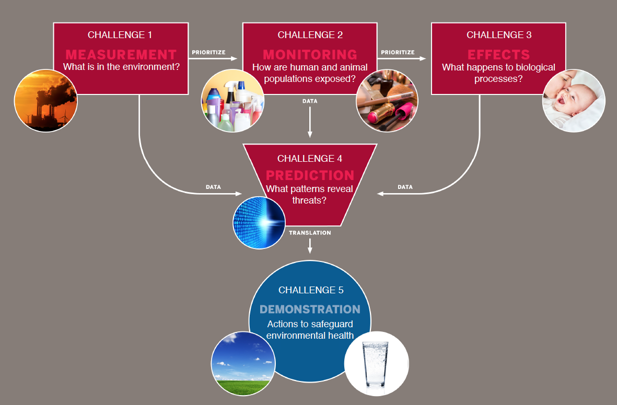Environment Care: Mapping the Chemosphere
- Dates
- Thursday 29 June 2017 (09:00-16:30)
- Contact
To register to attend this workshop please email Lauren Rawlins.

WORKSHOP LEADER: John Colbourne
THE PROBLEMS
The problems we know about are the tip of the iceberg. Efforts to track chemical concentrations and exposures have been limited to those few chemicals known to be harmful. Recognition of the urgent need to close these knowledge gaps has led the European Union to pass the Registration, Evaluation, Authorisation, and Restriction of Chemicals, and to require the regular monitoring and management of environmental health (e.g., Water Framework Directive). However, manufacturers are unable to comply with these regulations due to the high cost and slow pace of traditional testing systems, which require an average of £5 million and 5 years per chemical compound. Most EU member states have also been unable to comply with the legal directives of the WFD because of outdated methods of environmental risk assessment. Whether the UK continues to follow EU directives or creates its own environmental health policies, the challenges remain. As a result, despite the interest of government, citizens, and manufacturers in safeguarding health, the resources are not available to evaluate risks and ensure non‐toxic environments.
THE SOLUTION
Although the problems are global, the UK can lead at providing a solution that pools the brainpower and capacity of our experts and facilities across the academic community, by applying state-of‐the‐art methods and technology in analytical chemistry, environmental toxicology, systems biology, health research and predictive analytics to dramatically increase the pace and decrease the cost of evaluating chemical risks. The solution is research that is guided by a single yet comprehensive and scalable project, which is as powerful and revolutionary as mapping the human genome. A map of the chemosphere will reveal not only which chemicals are toxic, but also how chemicals disrupt biological processes and what molecular characteristics cause a chemical to be toxic in the environment. The ultimate outcome is a new knowledge-based Environment Care industry. The central argument for this approach is that unlike traditional research efforts and funding mechanisms, which artificially divide human toxicology and ecotoxicology, such a project will proactively uncover – and ultimately break – the chains of cause and effect that link chemicals to human suffering and environmental depredations.
INTERNAL ATTENDEES
David Hannah, GEES
Roy Harrison, GEES
Bill Bloss, GEES
Stuart Harrad, GEES
Mark Viant, Biosciences
Ben Brown, Biosciences
Iseult Lynch, GEES
Jean-Baptiste Cazier, CCB
Aleksandra Cavoski, Law
KK Cheng, Institute of Applied Health Research
Shan He, Computer Science
John Bryson, Business
David Maddison, Business
EXTERNAL ATTENDEES
Dave Spurgeon (CEH)
Susanna-Assunta Sansone (Oxford)
Gos Micklem (Cambridge)
Mireille Toledano (Imperial)
Stephen Holgate (Southhampton)
Mark Cronin (Liverpool John Moores University)
Jonathan Goodman (Cambridge)
Jonathan Essex (Southhampton)